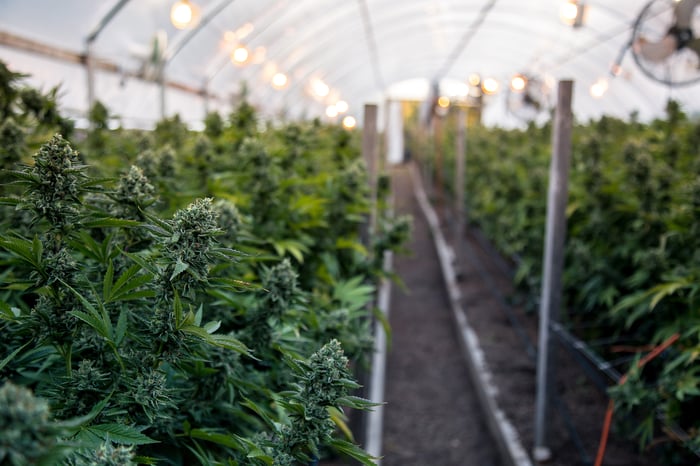That's right folks... it's earnings season yet again (does it ever really stop?), and within the marijuana industry, it looks as if Canadian-based grower Emerald Health Therapeutics (EMHT.F) is kicking things off.
As you might imagine, all eyes are on Canadian cannabis stocks given the expected legalization of recreational weed in the country by sometime this summer. If Canada votes to approve the Cannabis Act, it would become the first developed country in the world, and only the second overall behind Uruguay, to greenlight the sale of marijuana to adults over the age of 18. In the process, it would also be opening the door to $5 billion or more in annual sales for pot companies. It's these sales expectations that really have pot stock investors excited.
That being said, let's dig into Emerald Health Therapeutics' fiscal 2017 results, and then take a deeper dive into what really matters.

Image source: Getty Images.
Emerald Health Therapeutics' full-year results by the numbers
For the year, the company reported about $726,000 in sales, which probably doesn't sound like a lot. However, keep in mind that Emerald Health is in the process of expanding its capacity, with nearly all of its efforts focused on upping future production.
In terms of its bottom line, the company's per-share net loss doubled to $0.10 Canadian dollars from CA$0.05 in 2016. On a nominal basis, Emerald Health's net loss tripled to $6.76 million, with general and administrative expenses quadrupling and share-based payments rising by more than fourfold from the previous year.
Ultimately, though, marijuana stock investors aren't buying into the current earnings results of pot stocks -- they're buying into what they expect will be massive growth in the years to come. Contained within Emerald Health Therapeutics' report are three things bound to make these optimists very happy, as well as two worries that should make investors think twice.
Three things to love about Emerald Health's full-year report
Let's begin by focusing on what Emerald Health's shareholders and pot stock enthusiasts are bound to appreciate.

Image source: Getty Images.
1. Capacity expansion projects remain on track
To begin with, a comment from CEO Chris Wagner in the company's press release stands out. In describing the company's objectives for the upcoming fiscal year, Wagner states, "We are executing well on the projects we have announced and are assessing an array of potentially impactful new business opportunities."
They key point of the above statement is that Emerald Health remains on track and on budget with its two primary projects:
- A 1 million-square-foot build-out in Vancouver, British Columbia (B.C.) that will contain its corporate headquarters, as well as growing facilities.
- The co-owned Delta 3 greenhouse in B.C. with Village Farms International (VFF -3.32%), which is being retrofitted from tomato production to grow cannabis. This venture is known as "Pure Sunfarms."
The latter project is expected to produce at least 75,000 kilograms annually, with both projects likely pushing Emerald Health over 100,000 kilograms of fully funded production by 2020. Retrofitting an existing facility with Village Farms was a genius move by Emerald Health as it will save significant costs and time relative to building a new greenhouse from the ground up.

Image source: Getty Images.
2. An accelerated ramp up is possible
Secondly, Emerald Health suggests that there may be a way to expedite its capacity expansion in order to boost its production yield. As noted in the press release:
Pure Sunfarms is pursuing a strategy to potentially accelerate production using short-term rental generation equipment. This would provide incremental electricity to power supplemental lighting during the 2018/2019 winter months when there is insufficient natural sunlight available and prior to the installation of the approved additional 24MW from the local utility. Successful execution of this plan is expected to increase Pure Sunfarms' production in 2019 by up to 30% over the current target of approximately 35,000 to 40,000 kilograms of dried cannabis.
In other words, if the cards are laid out just right, Emerald Health and Village Farms may be able to squeeze out another 10,000 kilograms of production in 2019, right when demand for recreational cannabis is taking off. Though using rental equipment will somewhat eat into margins, the payoff would presumably be well worth it.

Image source: Getty Images.
3. Marijuana and blockchain?
There's certain to be excitement about two of the buzziest terms on Wall Street -- marijuana and blockchain -- coming together. In recent months, DMG Blockchain and Emerald Health announced their intent to form a joint venture to be named CannaChain Technologies, which will seek to create blockchain-based supply-chain management systems for the cannabis industry.
For those unfamiliar, blockchain is the digital, distributed, and decentralized ledger designed to record transactions or data in a transparent and immutable (i.e., unchanging) manner without the need for a bank. Blockchain offers the ability for cannabis producers to track production from seed to shelf in real time. It also offers an immutable log that could help with record keeping, such as to ensure that pot companies pay the correct amount of tax, or that grown cannabis is going where it should.
Though still nascent in its development, this joint venture sounds exciting.

Image source: Getty Images.
Two major concerns to be aware of
Then again, not everything in Emerald Health Therapeutics' full-year report was necessarily a positive. Here are two factors that current and prospective investors should be worried about.
1. Being late to the party
For starters, even with the possibility of using rental equipment to push along production, 35,000 kilograms to 40,000 kilograms of production, or even 10,000 kilograms over this range, could leave Emerald Health eating the dust of the big boys.
You see, the green flag on cannabis sales could wave as soon as August or September of this year, meaning Canopy Growth, Aurora Cannabis, Aphria, and all of the other significant growers that have production ready to roll once legal weed sales are authorized could gobble up long-term supply agreements. Even though Emerald Health is on track to eventually produce in excess of 100,000 kilograms of cannabis annually, it won't be anywhere near this amount until well after Canada legalizes adult-use pot. In other words, being late to the party could cost Emerald Health big time.

Image source: Getty Images.
2. Dilution
The other issue is something of a double-edged sword. On one hand, bought-deal offerings, which have allowed the company to sell common stock and warrants in order to raise capital, have given Emerald Health a solid cash cushion. It ended the full year with almost $34.5 million in cash and cash equivalents.
The problem is that these stock offerings and warrants, immediately and over time, increase the company's outstanding share count. That makes each existing share less scarce, therefore diluting existing and future investors. Based on its Canadian listing, the company's outstanding share count ballooned to 88.4 million from 54.3 million in the year earlier. This dilution may continue to haunt investors in the near-to-intermediate future.
For now, this investor would suggest keeping a safe distance from Emerald Health's stock until we know what supply and demand will look like in Canada.





